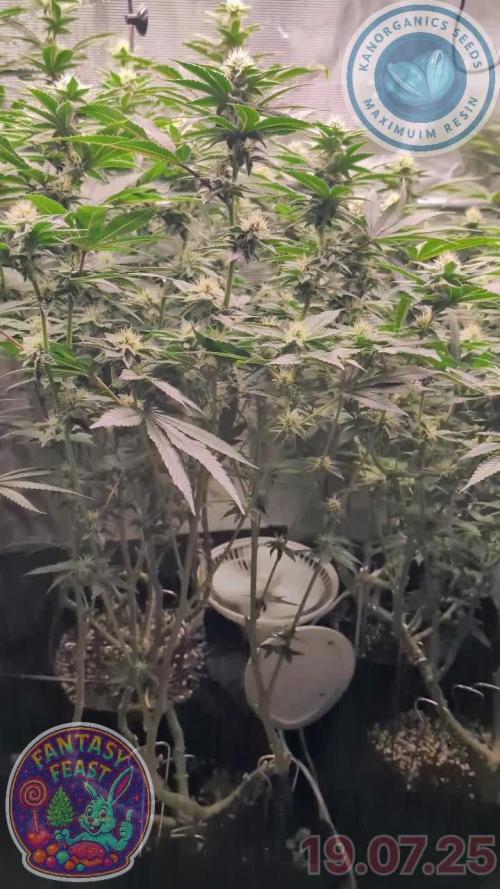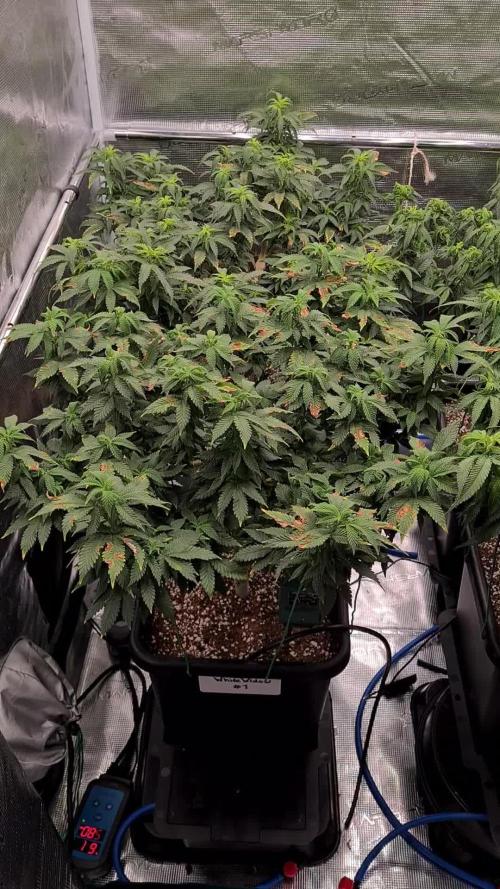The Grow Awards 2026 🏆 































Likes
Comments
Share


@RDWCGrowing
Follow
2/17/2024 - Vegetation Week 1 Day 1- I removed some of the water to see where the roots were only one had roots in the water. However I want to go ahead and get them on Week one Nutes So I am over 50 gallons of water in the system so I mixed the Trio at a 1.0mil per Gallon but restricted it to a top of 50 gallons period. I top fed the other two to keep encouraging root growth. I also finished my drying and curing from my last run and wanted to show what it looks like all bagged up and in the cannatrol.
I added the following Nutes:
Silica = .5Mil/Gal= 25Mil
CalMag= .75Mil/Gal= 37.5Mil
FloraMicro = 1Mil/Gal= 50Mil
FloraGro= 1Mil/Gal= 50Mil
FLoraBloom= 1Mil/Gal= 50Mil
ORCA = .5Mil/Gal= 25Mil
EPSOM- 1 big pinch
2/18/2024 - Vegetation Week 1 Day 2- I top fed #1 and #3 since they still don't have roots in the water, I will continue one top feed a day until roots hit water.
2/19/2024 - Vegetation Week 1 Day 3- #3 now has root in the water.. Yay!! I now have #2 and #3 with roots in the water so no top feed for them. I only had to top feed #1 and the only reason I didn't just go ahead and cull her today was I am responsible for breaking her tap root and stunting her, I wasn't careful enough and she was the first to show a good root. In that vain I will carry her a few more day's top feeding but if not root by the end of the week she is getting culled.
2/20/2024 - Vegetation Week 1 Day 4- Today I Ensured the PH is in range, I refilled the Humidifiers, I top fed #1 since the roots are still not in the water. I also removed the humidity shields from #2 and #3 today the ladies were touching the sides so they are done with the extra shields..
2/21/2024 - Vegetation Week 1 Day 5- Today Morning: I Ensured the PH is in range, I refilled the Humidifiers, I top fed #1 since the roots are still not in the water,
Evening: I decided that the roots of the two are looking great so I am going to drain and bump the Nutes to a full Week 1/ Week 2 Nute base.
I added 36 Gallons
I added the following Nutes:
Silica = .5Mil/Gal= 18Mil
CalMag= .75Mil/Gal= 27Mil
FloraMicro = 3Mil/Gal= 108Mil
FloraGro= 2Mil/Gal= 72Mil
FLoraBloom= 2Mil/Gal= 72Mil
ORCA = .5Mil/Gal= 18Mil
2/22/2024 - Vegetation Week 1 Day 6- Today I Ensured the PH was not too high as the system continues to cycle the water and adjust, I refilled the Humidifiers, I top fed #1 since the roots are still not in the water,
2/23/2024 - Vegetation Week 1 Day 7- Still have to Top Feed #1 no roots in the water, however she is still progressing nicely slower than her sisters with roots in the water but still going strong.
Likes
5
Share


@privateerjosh
Follow
OK so I nearly kill my plants and these were stunted and bonsai like.. Only got 30grams dry weight but were not all cbd and definitely contained thc.. Not so good for what the intended use..
But it's like opium...
Likes
18
Share


@Masterchief
Follow
Guys, it's week 8 and the Purple seem to be ready to be at the en of flowering stage...
I am really excited, but so afraid of doing a mistake...
I Will now flush her for 1 week of two maybe depending on me receiving my microscope on time!
For the amazing master KUSH, it is going well for the big one, budding seriously.
Her Lil sis is not going that well we'll see!
Enjoy my little video, if you like it please let me know and hit the like button :)
Love and peace ✌️✌️✌️
Likes
4
Share


@Chubbs
Follow
What up fam, weekly update on these gorgeous girls. They're showing preflowers now which I'm definitely happy as that means the stretch is almost over. I did add a 2nd scrog net its 6ft high. Now time to see them fatten up. Over all I couldn't be happier with how they've grown. Happy Growing.
Processing
Likes
6
Share


@AbbyRose
Follow
These chef anna white label autos are just amazing. The smell is so pungent it just smacks you in the face from 10 feet away. I cant wait to smoke these lovely ladys. Not to mention look at all those pistols.
Likes
210
Share


@yan402
Follow
🌸🍭✨🍬🌈🍭✨🍬🌸🍭✨🍬🌈
Hi and welcome to a first @KanOrganics
run!
This time I’m running Fantasy Feast (6x regular seeds). Gonna veg them under 24hr light with a mix of LST and topping — might let one go wild for fun.
Still prepping the tent, need to transplant all my tomatoe and paprika plants to free up some pots, gonna sow tomorrow (14.04.25)
🌸🍭✨🍬🌈🍭✨🍬🌸🍭✨🍬🌈
💭❗💭❗💭❗💭❗💭❗💭❗💭
❗Events & thoughts worth noting❗
💭❗💭❗💭❗💭❗💭❗💭❗💭
12.04.25 (GW1) Cleaning old coco coir & prepping pots. Might need to hydrate extra bricks.
This is how I recycle my coco coir — fast, cheap, no BS.
🌿 Harvest plant
✂️ Chop roots small — they stay in for structure (organic perlite)
💦 Hot water rinse — remove salts & dust
🍶 Pre-soak with light feed: Micro 10ml Grow 0ml Bloom 0ml GreenBuzz 10ml Cal-Mag 60ml FPJ 10ml pH down (citric acid)
♻️ Media stays — Roots stay — Back in service.
14.04.25 (GW1) Sow 6x Fantasy Feast ✅
16.04.25 (GW1) did final tent clean up and all set up now ✅📸📸📸
18.04 25 (GW1) All 6 germinated 🎉👌♥️📸
🙏@resi_max
26.04.25 (VW1) using the new Batch of FPJ/FFJ
https://growdiaries.com/diaries/266849-grow-journal-by-yan402
00.04.25 (?W?) Transplant to...WIP, ✅
04.05.25 (VW3) Topped all of them to the same size except #4 which probably won’t make it. #5 is showing classic small pot symptoms, all 6 are droopy so left them to dry a bit,I overwatered them apparently, I'll be repoting tomorrow in bigger pots probably 9l, *repoted in 11l pots✅
30.04.25 (VW2) – Increased TriPartMicro & GreenBuzzBloom 10ml → 15ml
03.05.25 (VW2) – Increased TriPartMicro again 15ml → 20ml
13.05.25 VW4 Increased TriPartMicro to 30ml and GreenBuzzBloom to 20ml.
24.05.25 VW6 increased GreenBuzzBloom to 30ml
01.06.25 VW7 At least 4 are female 🎉🥂
by next week I'll be choosing 2 or 4 to finish off.
05.06.25 VW7 Did a cleanup 📸📸
10.06.25 VW8 kept #1-4, #5 and #6 are going to the balcony with a new diary📸📸
14.06.25 VW8 did a cleanup HST session 📸📸
(VW9)
21.06.25 VW9 Switched lighting to 12 hours.
28.06.25 VW10 Girls a stretching nicely and are eager to show their pistils.
29.06.25 VW11 increased GreenBuzzBloom 30→ 60ml
06.07.25 FW1 TriPart Micro: 50→ 30ml
TriPart Bloom: 0 → 20ml
Home-made FFJ/FPJ (Watermelon + Pumpkin): 10 → 30ml
12.07.25 FW1 GreenBuzzBloom 60 →40ml, TriPart Bloom: 20 → 40ml, fpj 30→60ml
22.07.25 FW3 TriPartMicro 30→20ml , TriPartBloom 60→80ml , GreenBuzzBloom 40→50ml
24.07.25 FW3 Cal-Mag 60→40ml
💭❗💭❗💭❗💭❗💭❗💭❗💭
🌱💦🌱💦🌱💦🌱💦🌱💦🌱
🌿 Day to day tasks & actions 🌿
🌱💦🌱💦🌱💦🌱💦🌱💦🌱
19.07.25 FW2 – Fed 3l of #1 → 1.5l runoff
20.07.25 FW3 – Fed 3l of #1 → 1.5l runoff
21.07.25 FW3 – Fed 3l of #1 → 1.5l runoff
22.07.25 FW3 – Fed 3l of #1 → 1.5l runoff
23.07.25 FW3 – Fed 3l of #1 → 1.5l runoff
24.07.25 FW3 – Fed 3l of #1 → 1.5l runoff
25.07.25 FW3 – Fed 3l of #1 → 1.5l runoff
26.07.25 FW3 – Fed 3l of #1 50% strength→ 1.5l runoff
(*runoff reused for tomato plants)
🌱💦🌱💦🌱💦🌱💦🌱💦🌱🌱💦🌱
🍶💧🍶💧🍶💧🍶💧🍶
💧 Nutrients in 30L #1 – Week 2 flower
🍶💧🍶💧🍶💧🍶💧🍶
💧 TriPart Micro: 10 → 15 → 20 → 30 → 40 → 50ml → 30ml (1.00ml/L)
🍶 TriPart Grow: 0ml (0.00ml/L)
💧 TriPart Bloom: 0 → 20 → 60ml (2.00ml/L)
🍶 GreenBuzz Bloom: 10 → 15 → 20 → 30 → 60→40ml (1.33ml/L)
💧 Cal-Mag: 60ml (2.00ml/L)
🍶 Home-made FFJ/FPJ (new batch): 10ml → 60ml (2.00ml/L)
💧 pH Down: Citric acid (buxXtrade)
📦 TOTAL: 30+0+60+40+60+60 = 250ml per 30L
🔬 8.33ml/L
🍶💧🍶💧🍶💧🍶💧🍶
⚙️✂️⚙️✂️⚙️✂️⚙️✂️⚙️
✂️Tools & equipment✂️
⚙️✂️⚙️✂️⚙️✂️⚙️✂️⚙️
✂️ 2× MarsHydro SP3000
⚙️ MarsHydro 150mm ACF Ventilator
✂️ Trotec dehumidifier (big unit)
⚙️ Mini no-name dehumidifier
✂️ Kebab skewers (LST – stainless)
⚙️ Wire + roast skewers (LST assist)
✂️ Scissors (HST)
⚙️ Vacuum (for spills & cleanup)
⚙️✂️⚙️✂️⚙️✂️⚙️✂️⚙️
🌈🍒🍭🍬🌈🍒🍭🍬🌈🍒🍭🍬🌈🍒
🦄Fantasy Feast(@resi_max Seeds)🦄
🌈🍒🍭🍬🌈🍒🍭🍬🌈🍒🍭🍬🌈🍒
Species: Hybrid (Regular)
Genetics: The mother is Unicorn Whip by Dirty Bird Genetics. The father is Charcuterie by Cannarado Genetics.
Effect: Unknown WIP
Flavor: Unknown WIP
Flowering: Estimated 8–10 weeks
Resistance: Unknown — Testing phase
Notes: Expect weird phenos, candy terps, possible outliers
Likes
16
Share


@AutoCrazy
Follow
Week 5 of flower:
Well I had held out hope that this plant was just a late bloomer and she would really burst into flowering but that hope has faded. I think there is a combo of things at play here. One is just genetics. It’s always a role of the dice when it comes to starting from seed. Also, I had set up my air stones in a different orientation and unbeknownst to me it had created a bit of a whirlpool within the cooler and the roots wrapped up on themselves. This stunted grow a bit as well I am sure.
The smell of this plant is out of this world though!! It’s a sweet orange scent that is just intoxicating so I will have to run this again next run and try to get a better flowering phenotype.
Onward 😎🍻
Likes
Comments
Share


@Nobody1991
Follow
It is a vigorous plant with very uniform branching, high resinous and high yield, if you grow from seed there are a few different phenos that I got, equally as good
Likes
9
Share


@BLAZED
Follow
Week 13 (9-9 to 15-9)
9-9
Temps: 18.8 to 27.6 degrees
Humidity: 48% to 67%
Watering: Both 600 ml.
Decreased the light intensity from 50% to 40%
10-9
Temps: 19 to 24.2 degrees
Humidity: 51% to 58%
Watering: Both 500 ml.
Dry Weight #1 3.2 kg. #2 2.8 kg.
11-9
Temps: 16.5 to 22.5 degrees
Humidity: 50% to 62%
Watering #1: 1000 ml. #2: 1400 ml.
Dry Weight #1 3.5 kg. #2 3.0 kg.
12-9
Temps: 18.5 to 23.6 degrees
Humidity: 50% to 55%
Watering: Both 500 ml.
Dry Weight #1 3.8 kg. #2 3.4 kg.
13-9
Temps: 19.9 to 23.1 degrees
Humidity: 49% to 59%
Watering #1: 500 ml. #2: 1000 ml.
Raised the light to 65 cm distance of the top canopy.
Dry Weight #1 3.8 kg. #2 3.4 kg.
14-9
Temps: 19.5 to 23.4 degrees
Humidity: 50% to 60%
Watering: Both 500 ml.
Dry Weight #1 4.2 kg. #2 3.8 kg.
15-9
Temps: 20.5 to 24.7 degrees
Humidity: 54% to 61%
Likes
23
Share


@Chubbs
Follow
420 Fastbuds Week 1
Gorilla Zkittlez Auto
Hey hey what up grow family. Started another couple seeds from 420Fastbuds of this amazing looking strain Cherry Cola Auto. Germination started on 9/21 and 48hrs later after soaking in a glass of water they where put into the soil. Fast forward 48 more hours and we have sprouts that appear to be healthy.
All in all Happy Growing
Likes
1
Share


@Growedbypepper
Follow
Esta planta solo tiene 1 semana en floración y esa misna semana paso de una maceta de 5 litros ah una de 20 litros...
Likes
78
Share


@Hou_Stone
Follow
Hello friends, another beautiful day for growing indoors🌞
Here are my 4 plants which are continue to grow 🌿
✂️This week I am doing a light defoliation on my Bana Krumble🍌, I will continue in the coming weeks to reduce the humidity in the tent starting with the leaves and new shoots from below which capture less light from the lamp
⌚️At the end of this week I start to reduce the schedule where my lamp is on by 1 hour per day to reach 12 hours of day and 12 hours of night next week and start flowering.
------------------------------------------------------------
💧Watering each pot:
Day 25 : 0.5 L
Day 28 : 0.5 L
I use tap water, adjust the ph to around 6 and water
------------------------------------------------------------
🔥❄️Temperature of the week :
Day : 19-23°C (Humidity : 60-75%)
Night : 14-17°C
------------------------------------------------------------
🚀Equipment of the week ⭐️ :
Light FC3000 Mars hydro. power 95% at 50cm
Extractor 6 inch Mars Hydro. power 1/10. ON 24/24h
2 fans to circulate the air inside the tent. Each on for 30 minutes then off for 1 hour. this rhythm repeats itself in a loop
Heating mat 95x95cm. ON 45 minutes. OFF 30minutes. In a loop. The day only
------------------------------------------------------------
🌎 I created my discount code on Mars Hydro.
Get 5% off with my code: houstone5
By using a code, in addition to getting a discount, you directly support the creator who shares it.🙏
So if you make purchases on Mars Hydro don't forget to enter a code😀
Mine is "houstone5" 😉
https://www.mars-hydro.com/?acc=hou-stone
-----------------------------------------------------
My instagram 👨🚀🌱 :
https://www.instagram.com/hou_stone420/
------------------------------------------------------
Thanks for your visit 💚😀
Likes
6
Share


@Discepolo
Follow
I am shocked😱...because...
Overwatering problem got more serious than last week on one bimba, that is not cooping well as others with water is getting.(I am on auto pot system)
I really think that forgetting to put the clay at the bottom of my vase on the airdome will give me some challenges.
Me and my bambine are ready for the fight!👊👊👊
We will not give up👽
Likes
4
Share


@torresgrow
Follow
700 ppm 5.9ph at least day 20/02 then I realize that she was hungry and start up ppm, 900 ppm and get a runoff of 850 ppm
Likes
422
Share


@Crashoverite
Follow
Hi all 🧑🌾
Welcome to my 🍌💜👊 week update.
Hope everyone keeping well and having a good week.
Thank you so much for your support on this bananas journey 💜💚💜💚
I am so happy to see how girls are developing in recent days. It's seems that Athena finally stopped her stretch and hoping that Xena will follow her sister very soon. Buds are gaining weight and size rapidly. Lots of nice colours and tonnes of trichomes on those buds already.
Week 10
Dec 18-24
Dec 18-19
Mainly observation. Xena is still stretching like crazy. both girls are developing beautifully.
Dec 20
First watering for this week. 7.5 ltr beetwen both. Runoffs PH's Athena 6.2 Xena 6.3.
Dec 21
Due to lack of light at lower parts of conopy decided for another selective defoliation, lowered a bit tallest branches with colas dangerously close to light by tieing them to netting. Couple cm will make a huge difference here. Could not clear well at the back wall of the cabinet due to limited access.I'm very happy with final result.
Dec 22-23
Joyful observation of my 🍌💜👊girls development 🧑🌾
Dec 24
All is looking great. It's seems that stretch is finally stopped. Girls looking healthy and happy.
Second watering for this week. 8 ltr beetwen both. Both runoffs PH 6.2.
It's the end of this week.
Happy Xmas everyone 🤶🎄❄️🎁☃️✌️💚🌲🎅🎄
Stay tuned for new week update ✨🍀✨✌️💚
Likes
1
Share


@047BrunoGrower
Follow
She looks beautiful and has fully recovered from the period when she was held back by over-watering
PPFD 600
VPD 1.19






















